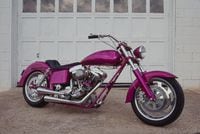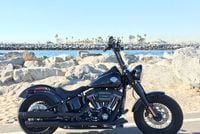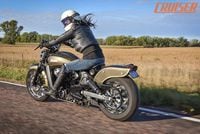Harley-Davidson Softail
An overview of Harley-Davidson Softail cruisers and the custom motorcycles built using them
With more than 30 years in production, Harley-Davidson Softail models have cemented their reputation as one of The Motor Company’s most iconic and well-loved motorcycles. The Softail family brings a wide variety of styling options, with their designs offering everything from classic cruiser to all-out hot rod. Whether it’s the Street Bob, Heritage Classic, or the wicked FXDR power cruiser, Harley Softail motorcycles definitely have something for everyone.
“Softail” refers to the fact that this model uses a hidden rear shock absorber to absorb bumps, but the appearance is that of a hardtail frame. Harley trademarked the word “softail” with the release of the FXST Softail in 1984, and there’s been a parade of Harley models bearing the Softail frame since then. All the bikes (with the exception of the Deuce) have had the same engine, transmission, and frame, with only the choice of fork, wheels, and accessories to set them apart.
That all changed in 2017, when Harley overhauled the entire Softail lineup and completely redesigned the frame for the 2018 model year. The 2018 Softail frame uses a differently shaped swingarm that’s suspended by a single conventional rear shock mounted underneath the saddle, with the new chassis being significantly stiffer and lighter than previous-generation Softail and Dyna platforms. Two different swingarm shapes are used, as well as three different steering neck angles to tweak each model’s individual setup. (As part of the overhaul Harley decided to retire the Dyna series, but some of those models were absorbed into the new Softail line.) The Softails come with either Milwaukee-Eight 107 or 114 engines.
Pros: Most reviews for the 2018 redesigned-frame Harley-Davidson Softails have been overwhelmingly positive, with reviewers citing improvements like the bike’s lighter weight, increased power with the Milwaukee-Eight engine, less vibration, and less heat.
Harley-Davidson Softail Prices in 2018
- Street Bob: $14, 549
- Low Rider: $15,049
- Softail Slim: $15,949
- Fat Bob: $17,949
- Deluxe: $18,049
- Sport Glide: $18,649
- Breakout: $19,049
- Fat Boy: $19,049
- Heritage Classic: $19,049
- FXDR 114: $21,000
Harley-Davidson Softail Slim
Originally introduced in 2012, the Softail Slim is a perfect example of just how versatile the new Softail frame is, offering a low stance, lighter weight, and a slimmer profile that makes it a good fit for smaller riders. That doesn’t mean the Harley-Davidson Softail Slim skimps on attitude, with lots of minimalistic styling details like bobbed fenders, spoked wheels, solo saddle, and blackout paint that reference post-war custom trends quite nicely. And with the 107ci Milwaukee-Eight V-twin delivering a claimed 100-plus foot-pounds of torque, the Harley Softail Slim goes far beyond “retro tribute” territory; this is a true ripper of a bike.
Harley-Davidson Softail Heritage Classic
Evolved from the chromed-out, full-fendered Heritage Softail Classic, the Harley-Davidson Heritage Classic is one of The Motor Company's most-recognized models. Although it's now more subdued than its flashy predecessor, it still has more to offer than its Softail stablemates, in the form of comfy ergonomics, onboard storage, and wind protection. Light-duty touring riders will love its removable and locking “sagless” leather saddlebags, and the windshield is easily removable too, thus transforming the Harley-Davidson Softail Heritage Classic from touring rig into around-town cruiser with the snap of a finger (or two). To top it off, the Heritage Classic boasts subtle vintage details and a refined powertrain and chassis combo, and is available in both 107 and 114 engine configurations.
Harley-Davidson Softail Deluxe
Now here's a gorgeous, head-turning, show-stopping classic. Sporting chrome laced wheels with fat whitewall tires, big wrapped fenders and an aura of reserved nostalgia, the Harley-Davidson Softail Deluxe was born to take on the boulevard. The beautiful detailing includes retro-modern-styled LED lighting with updated running lights and turn signals, a tombstone taillight, plump solo seat, floorboards, and other slick touches of classic ’50s design. Mile-wide pullback handlebars make it easy to leverage this big cruiser around, while the adjustable Softail monoshock rear suspension preserves the Harley-Davidson Softail Deluxe’s classic hardtail look, with a Milwaukee-Eight 107 engine to put the power to the ground.
Harley-Davidson Softail Breakout
Long and low, but also plenty beefy, the Harley-Davidson Softail Breakout comports itself as a muscular modern chopper that's just dripping with attitude. The classic dragbike styling starts with a chunky 240mm rear tire and a 21-inch Gasser front wheel, with a drag-style handlebar mounted high with gauges placed right in your line of sight. The Softail Breakout’s frame provides lightness and stiffness for quick maneuvers, while the front fork features a sophisticated new Showa dual-bending valve design to gobble up the bumps. The Softail monoshock at the rear is adjustable for preload, and can be changed easily via an adjuster on the side as well. The Harley-Davidson Softail Breakout is available in 107 and 114 engine displacements, but given its built-in menace and bad attitude, it seems only natural to go big.
Harley-Davidson Softail Fat Boy
In 1990, one of the most popular Softails ever made was dropped into an unsuspecting world. With its distinct, meaty headlight housing, fat fuel tank, and massive, solid wheels, even non-motorcyclists now recognize the Harley-Davidson Softail Fat Boy. The original fat custom is lighter than the previous-generation model and rolls with acres of satin chrome, though the rear stays plenty meaty thanks to a solid cast aluminum disc wheel wearing a 240mm rear tire. The Harley-Davidson Softail Fat Boy's new, lighter Softail frame offers a more responsive ride but retains those classic hardtail lines, and is available in a Milwaukee-Eight 107 or 114 Big Twin engine to keep the muscularity consistent even down to the powertrain.
Harley-Davidson Softail Street Bob
The stripped down, bare-bones entry to the Big Twin family was the first “Dark Custom” designed for Harley-Davidson’s Dyna family back in 2006. In true bobber style, the Harley-Davidson Street Bob keeps things simple, with a solo seat, skimpy fenders, mid-mount controls, and a retro-style air cleaner cover, for a true fists-in-the-wind riding experience. The mini ape handlebars, spoke wheels, and hidden instrumentation (mounted between the handlebar clamps) mean you get a dash of just-right style and a modicum of function on this least expensive member of the Softail family. With a Milwaukee-Eight 107 engine to rip you around the turns, the Harley-Davidson Street Bob is as fun a ride as it gets.
Harley-Davidson Softail Fat Bob
Introduced into Harley’s Dyna family back in 2008, the Harley-Davidson Softail Fat Bob is one of just a few FXD models that made the cut for the new 2018 Softail lineup. Immediately recognizable by its cast wheels and chunky tires with dual disc brakes, bold LED front lighting, and a 2-1-2 upswept exhaust, Milwaukee bigwigs called the Fat Bob, at its 2017 introduction, the “bike you’d use to escape the zombie apocalypse.” Now blacked out and even more souped up, the Harley-Davidson Softail Fat Bob brings the same aggressive modern-custom vibe but with a choice of either the 107-inch Milwaukee-Eight or the 114-inch version along with that upgraded suspension, making it even more punchy than before.
Harley-Davidson Softail Low Rider
Another Dyna that got absorbed into the new Softail line was the Harley-Davidson Softail Low Rider. As with the rest of the new Softails, the Low Rider comes standard with the Milwaukee-Eight 107ci Big Twin which is rigid-mounted in the frame, so the chassis is stiffer and handling is greatly improved. Styling is updated, of course, with a new 2-into-2 shotgun exhaust replacing the previous 2-into-1 unit. There’s now also a 16-inch rear wheel, but call-outs to the original model from the ’70s can be spotted in the tank graphics and dual-clock, tank-mount instrument panel. The Harley-Davidson Softail Low Rider also gets the Showa Dual Bending Valve fork and new adjustable monoshock rear suspension as upgrades.
Harley-Davidson Softail Sport Glide
There’s no predecessor to the Harley-Davidson Softail Sport Glide because it was an all-new model from The Motor Company in 2018. The new Sport Glide wears a mini-fairing (that looks like a 7/8-scale Batwing fairing) which can be quickly removed without tools, and along with the lockable saddlebags (which are also detachable) give the Harley-Davidson Sport Glide some light touring capabilities but also great versatility; if you want to go lighter in town or simply need a cleaner cruiser look, the saddlebags and mini-fairing are a cinch to swap out. The lightweight Softail frame makes for a nimble ride, and gobs of torque from the blacked-out Milwaukee-Eight engine gives the Harley-Davidson Sport Glide plenty of get up and go.
Harley-Davidson Softail FXDR 114
The newest member of the Softail family is definitely the most unruly: say hello to the Harley-Davidson Softail FXDR 114. As the tenth model in Harley’s new generation Softail line, this bike shares the same chassis with the other Softails, but it’s only available with the 114-cubic inch Milwaukee-Eight engine. The FXDR 114’s jet-fighter-inspired styling, as well as an inverted fork and a forward-facing air intake cement its performance intent. Suspension upgrades include a new aluminum swingarm that lessens chassis weight, and a revised position for the coil-over rear shock. Inspired by the dragstrip, the Softail FXDR 114’s edgy aesthetic and all-out performance is hard to overlook.
Custom Harley-Davidson Softail
Harley-Davidson Softails have had a long history with the custom world, but let's face it: they were never intended to be top-shelf performance machines. Jim Davis engineered his original Softail suspension as a way to sneak in a rigid frame look that wouldn't also produce a butt-crushing ride, but Dynas were far better-equipped to handle wheelies and canyon-carving sessions. After the introduction of the Fat Boy in 1990, public adoration of the Softail hit its apex, with custom Harley-Davidson Softails riding the wave of popularity into the early 2000s with the rigid frame chopper trend. Now that some of the Dynas have merged into the big Harley Softail family, there's no doubt we'll see some insanely cool configurations from the custom community.
Harley-Davidson Softail Parts and Accessories
There are any number of sources you can hit up to score parts and accessories for your Harley-Davidson Softail, including the Motor Company itself, which offers up literally hundreds of genuine factory-authorized items specific to your particular model.
The aftermarket options are almost literally infinite. For performance needs, most riders will first proceed straight to Harley's own in-house performance division, Screamin' Eagle. To find all kinds of power-boosting Harley-Davidson Softail parts and accessories, Screamin' Eagle is a sure bet.



/cloudfront-us-east-1.images.arcpublishing.com/octane/XBWZC3VR36YQWTZUWYZAO5T7RQ.jpg)